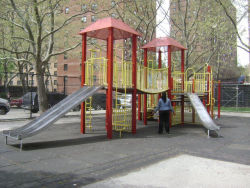Renaissance Playground
Renaissance Playground
P.S. 194, also known as the Countee Cullen Literacy Academy, was built in 1939. The school playground opened on November 19, 1962 with courts for paddle tennis, handball, basketball, volleyball, and shuffleboard; kindergarten and school gardens; and an open area for playground ball and roller skating. The school playground expanded to the west after 1965 when the City of New York acquired additional land between the school and the Alexander Hamilton Houses.
The Countee Cullen Literacy Academy is named for the brilliant poet and novelist who was born Countee Leroy Porter (1903-1946). Private by nature, the stories of his youth were never clearly established by him or his biographers. Cullen himself would always claim New York City as his birthplace, though others claimed it to be Louisville, Kentucky. According to some, the young Countee moved to New York with his grandmother and was later adopted by Reverend Frederick Asbury Cullen, pastor of the Salem Methodist Episcopal Church. Cullen was a graduate of DeWitt Clinton High School in the Bronx, and won numerous poetry awards and published his works in national magazines while earning his bachelor’s degree from New York University. Before he graduated from Harvard University with a master’s degree in 1926, he had already published his first book of poetry, Color. Cullen returned to Harlem to work as an assistant editor of Opportunity: A Journal of Negro Life, and later won a Guggenheim fellowship to travel in France. Upon his return to New York City in 1934, Cullen taught at Frederick Douglass Junior High School in Harlem. He died in New York in 1946.
Countee Cullen was one of the many artists and writers who participated in the Harlem Renaissance, a remarkable artistic and literary movement that blossomed in the 1920s and 1930s. The flourishing of African-American businesses, religious institutions, and political movements provided the backdrop for achievements in literature and the arts. While periodicals such as Crisis and Opportunity served as the arena for established intellectuals like W.E.B. DuBois and young talents like Langston Hughes and Zora Neale Hurston, African-Americans produced innovative works of poetry, fiction, and sociology. Pioneers like Noble Sissle, Eubie Blake, and Fletcher Henderson broke new ground in the performing arts. Contemporary visual artists included painter Aaron Douglas, sculptor Augusta Savage, and photographer James Van Der Zee.
The Harlem Renaissance lent its name to this school playground, which underwent a renaissance of its own under the New York Junior League’s For Kids By Kids Playground Improvement Project. In the spring of 1999, the New York Junior League, several community groups, P.S. 194, the City Parks Foundation, and Parks joined forces to improve Renaissance Playground. Hundreds of volunteers helped to install new play equipment funded by the New York Junior League and the City Parks Foundation in a “community build” on May 1, 1999. Additional plantings and cleanings have brightened Renaissance Playground.
Volunteers also painted the play equipment in the children’s garden, painted game surfaces and decorative patterns on the asphalt pavement, and painted murals on the park house and school walls. The murals were inspired by The Lost Zoo (1940), a children’s book written by Countee Cullen. The paintings reflect the Countee Cullen Literacy Academy’s motto “Open a Book, Open Your Mind, Open the World.” The colors and design of the park house mural were derived from French artist Henri Matisse’s mural entitled “Music.”
Check out your park's Vital Signs
Clean & Safe
Green & Resilient
Empowered & Engaged Users
Share your feedback or learn more about how this park is part of a
Vital Park System





